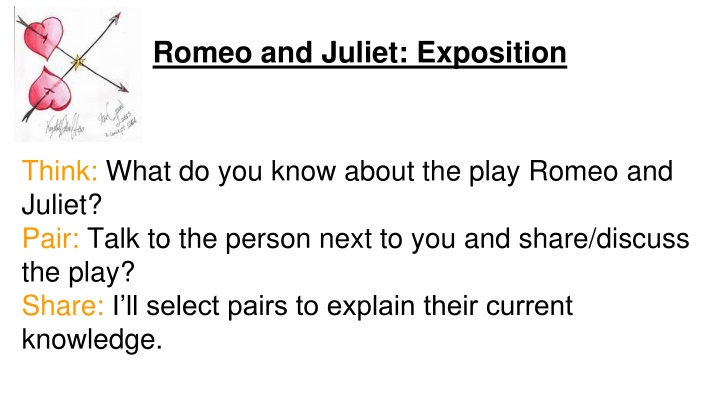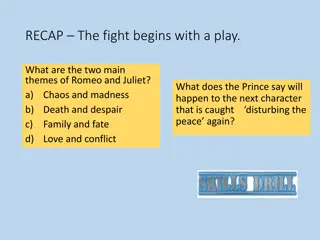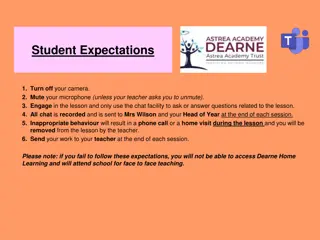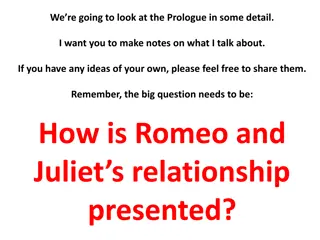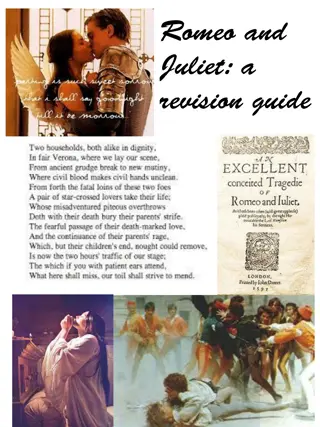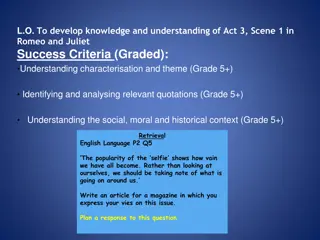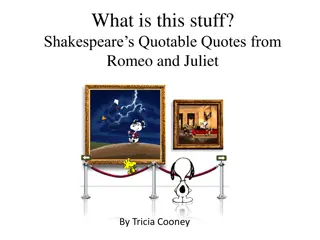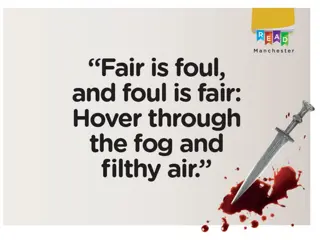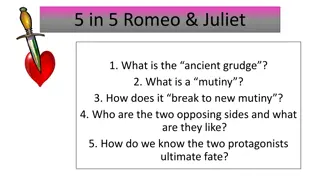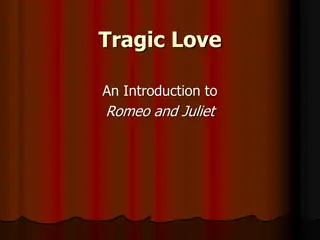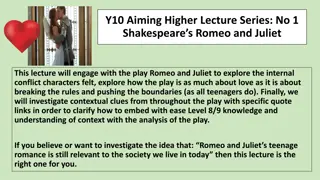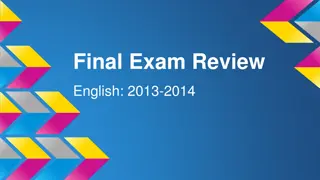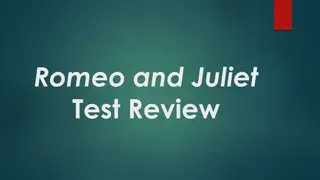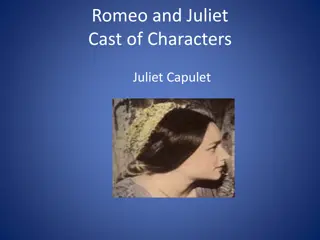Insights into Romeo and Juliet
Delve into the themes and relevance of Shakespeare's classic play Romeo and Juliet, exploring the timeless story of love, tragedy, and family feud in Verona. Gain new perspectives on character dynamics and discover why this tale continues to resonate with audiences today.
Download Presentation

Please find below an Image/Link to download the presentation.
The content on the website is provided AS IS for your information and personal use only. It may not be sold, licensed, or shared on other websites without obtaining consent from the author.If you encounter any issues during the download, it is possible that the publisher has removed the file from their server.
You are allowed to download the files provided on this website for personal or commercial use, subject to the condition that they are used lawfully. All files are the property of their respective owners.
The content on the website is provided AS IS for your information and personal use only. It may not be sold, licensed, or shared on other websites without obtaining consent from the author.
E N D
Presentation Transcript
Romeo and Juliet: Exposition Think: What do you know about the play Romeo and Juliet? Pair: Talk to the person next to you and share/discuss the play? Share: I ll select pairs to explain their current knowledge.
Romeo and Juliet: Exposition What themes do you think are being revealed and why? A02 - Understanding how a writer creates meaning.
Romeo and Juliet: The Prologue Two households, both alike in dignity, In fair Verona, where we lay our scene, From ancient grudge break to new mutiny, Where civil blood makes civil hands unclean. From forth the fatal loins of these two foes A pair of star-cross'd lovers take their life; Whole misadventured piteous overthrows Do with their death bury their parents' strife. The fearful passage of their death-mark'd love, And the continuance of their parents' rage, Which, but their children's end, nought could remove, Is now the two hours' traffic of our stage; The which if you with patient ears attend, What here shall miss, our toil shall strive to mend A02 - Understanding how a writer creates meaning. What is a prologue? What is dramatic irony? Task: translate into modern language.
Romeo and Juliet: Relevance How is Romeo and Juliet still relevant to young people today? (AO3 - Context Link) AO3 - Context Understanding the impact of the play at the time - Shakespearean audience effect/reaction or modern day relevance - contemporary reaction
Romeo and Juliet: Relevance Plot Understanding and characters. While watching the animated tales. Make notes: AO1 - Understanding the story Who do you meet? Which family? What new information do you learn? Animated Tales R&J
Romeo and Juliet: Relevance How is Romeo and Juliet still relevant to young people today? (AO3 - Context Link) AO3 - Context Understanding the impact of the play at the time - Shakespearean audience effect/reaction or modern day relevance - contemporary reaction
Romeo and Juliet: The Prologue Two households, both alike in dignity, In fair Verona, where we lay our scene, From ancient grudge break to new mutiny, Where civil blood makes civil hands unclean. From forth the fatal loins of these two foes A pair of star-cross'd lovers take their life; Whole misadventured piteous overthrows Do with their death bury their parents' strife. The fearful passage of their death-mark'd love, And the continuance of their parents' rage, Which, but their children's end, nought could remove, Is now the two hours' traffic of our stage; The which if you with patient ears attend, What here shall miss, our toil shall strive to mend A02 - Understanding how a writer creates meaning. What is a prologue? What is dramatic irony? Task: translate into modern language.
Romeo and Juliet: Relevance Plot Understanding and characters. While watching the animated tales. Make notes: Characters: The Nurse (Juliet s maid) Friar Laurence (Priest) Prince Escalus (Law) Mercutio (Romeo s friend) Benvolio (Romeo s cousin) Tybalt (Juliet s cousin) Lord and Lady Capulet Lord Montague AO1 - Understanding the story
Romeo and Juliet: Prologue & Dramatic Form Plot Understanding and characters. AO1 - Understanding the story What do you remember from the animated tales about the play?
Romeo and Juliet: Model Prologue MODEL: How does Shakespeare present the story of the play Romeo and Juliet in the prologue? WHAT: Answer the question HOW: Include methods and evidence from the prologue WHY: explain the meaning of the evidence and why it is important? Shakespeare presents the story of Romeo and Juliet by telling us the story in the prologue. First, the two similar families (Capulets and Montagues) fight: Two families both alike in dignity is a metaphor to show that the families are very similar to each other and the adjectives in from ancient grudge break to new mutiny describe the fact they have a mutual dislike, hatred and intolerance and they have started fighting again, because they can t move on from their old hatred of each other, ironically no valid reason is revealed in the prologue. Then, we learn that two characters from each family fall in love two star cross d lovers shows that they are not supposed to be together, but are. They die as a result of suicide take their lifes which is upsetting and horrible deaths reflecting the speed with which they get together and the terrible consequences due to their impetuous natures. However, the ancient grudge is stopped because of their deaths implying that the old arguments could have been stopped a long time ago and they might have avoided the deaths of both their children. Shakespeare s dramatic irony shows us the tragic ending before we have watched Romeo and Juliet fall in love. AO1 & 2 - Understanding the story and how Shakespeare creates meaning
Title: Shakespeare and Dramatic Form LO: to identify and comment on the key features of drama including the form, audience, and Elizabethan theatre (AO3). As well as poems called sonnets, Shakespeare wrote plays in three genres/forms: Comedy Tragedy History AO3 - Context Hamartia: a fatal flaw leading to the downfall of a tragic hero or heroine. Consider: What might Romeo s hamartia be? What might Juliet s hamartia be?
Title: Shakespeare and Dramatic Form Tragedy We are particularly interested in Tragedy this year. AO3 - Context As a class, let s explore any features of tragedy that you could remember.
Title: Shakespeare and Dramatic Form Tragedy We are particularly interested in Tragedy this year. AO3 - Context As a class, let s explore any features of tragedy that you could remember.
Title: Shakespeare and Dramatic Form Tragedy Did you have? - One main character - often has their name as the title of the play This main character is usually from a noble family The main character has heroic qualities but also one fatal flaw (hamartia) The main character often suffers from false pride (hubris) Fortunes are often reversed AO2 - Form of the play - - - - AO3 - Context Challenge: did you know this had its roots in Classical (Ancient Greek) theatre?
Title: Shakespeare and Dramatic Form Tragedy However, there was another type of tragedy (sometimes spelt tragedie) that existed in medieval times. AO2 - Form of the play This was the idea that what happened to the main characters was as a result of fate or fortune and the characters had little or no control over their fate. AO3 - Context
Title: Shakespeare and Dramatic Form Romeo and Juliet is a Tragedy. Some critics argue that it is more a tragedy in the medieval sense than the classical. AO2 - Form of the play In a nutshell, critics argue about whether Romeo and Juliet really had a hand in their downfall or whether they were the victims of other forces. You will be able to decide for yourselves. AO3 - Context
Title: Shakespeare and Dramatic Form Sort the statements into Classical or Medieval tragedy: A The character/s have a fatal flaw that leads to their downfall B The character/s have little control over what happens to them C There is one main character who often suffers from false pride (hubris) D The character/s are affected by the forces of Fortune or Fate
Context in Elizabethan Times Men and Teenage Boys in the 1500s Free to roam the streets (roam - walk around) Free to drink and party Free to have sex and visit prostitutes In charge of their sisters and, once they became adults, in charge of their mums. Father head of the house Kept the honour of the family. Any insult was treated with violent reactions. AO3 - Context Understanding what it was like at the time and the impact of this - Shakespearean audience effect/reaction or modern day relevance - contemporary reaction Other points Catholics were persecuted and many were executed or tortured. Priests were subjected to hanging, drawing and quartering. Children were regarded as the property of their parents. Juliet was written as being 13. Answer the questions: What was it like to be a man or a young boy in the 1500s? What danger was there from religion?
Context in Elizabethan Times Women in Shakespeare s Time Women had to obey their husbands, brothers and fathers. This is why Queen Elizabeth always refused to marry. Women, especially those with high status, would have had to stay in the family home. Women, especially those with high status, would have had to dress modestly in public and cover their heads. Women were subject to patriarchal rule where men were more important in society than women. AO3 - Context Understanding what it was like at the time and the impact of this - Shakespearean audience effect/reaction or modern day relevance - contemporary reaction Answer the questions: What was it like to be a woman or teenage girl in the 1500s? What was the difference for men and women?
Context in Elizabethan Times Women in Shakespeare s Time Women had to obey their husbands, brothers and fathers. This is why Queen Elizabeth always refused to marry. Women, especially those with high status, would have had to stay in the family home. Women, especially those with high status, would have had to dress modestly in public and cover their heads. Women were subject to patriarchal rule where men were more important in society than women. AO3 - Context Understanding what it was like at the time and the impact of this - Shakespearean audience effect/reaction or modern day relevance - contemporary reaction Answer the questions: What was it like to be a woman or teenage girl in the 1500s? What was the difference for men and women?
Act 1 Scene 1: Summary - We will complete this before continuing to read Sampson and Gregory (Capulet servants) are getting angry about the Montagues and threatening to rape Montague women. Montague servants arrive and they fight as the Capulets insult them. Prince Escalus threatens death if they don t stop fighting. Tybalt and Benvolio had been fighting. AO1/2/3 - Understanding the play Analysing the language and structure Contextual relevance
Act 1 Scene 1: Masculinity & Love Reading Cast List: (Volunteers please) Sampson - Capulet servant: Gregory - Capulet servant: Benvolio - Romeo s cousin Montague: Tybalt - Juliet s cousin - Capulet: Officers (Law): Capulet - Juliet s father: Lady Capulet - Juliet s mother: Montague - Romeo s father - Lady Montague - Romeo s mother: Prince Escalus (Law): Romeo - the son of the Montague s Stage directions: AO1/2/3 - Understanding the play Analysing the language and structure Contextual relevance
Act 1 Scene 1: Summary - Continued Romeo and Benvolio s conversation When Benvolio speaks to Romeo, their dialogue reveals that Romeo s sadness is linked to love. Rosaline (Juilet s Cousin) is a great beauty but has sworn to become a nun, therefore can t love him back (unrequited love.) Romeo reveals how difficult and painful he finds love through multiple oxymorons O brawling love as he should feel light, joy and happiness but instead is weighed down with despair. AO1/2/3 - Understanding the play Analysing the language and structure Contextual relevance
Benvolio: I do but keep the peace. The Prince: If ever you disturb our streets again, Your lives shall pay the forfeit of the peace. Tybalt: peace? I hate the word, as I hate hell, all Montagues and thee coward. Masculinity The playwright, Shakespeare, has specifically opened the play using a range of male characters. How does Shakespeare present masculinity at the start of the play? What synonyms can you think of for masculinity? We will analyse these for meaning, effect and methods as well. Lord Capulet: My sword,, I say! Old Montague is come, And flourishes his blade in spite of me. Lord Montague: Thou villain Capulet! Hold me not, let me go.
Act 1 Scene 1: Love How does Shakespeare present love in A1S1? AO1/2/3 - We will annotate for meaning, effect and methods again. Montague: With tears augmenting the morning dew. Understanding the play Analysing the language and structure Contextual relevance Benvolio: Alas that love, so gentle in his view, Should be so tyrannous and rough in proof! Then she has sworn she will live chaste.? Romeo: O teach me how I should forget to think. Romeo: O brawling love, O loving hate, O anything of nothing first create! O heavy lightness, O serious vanity!
Act 1 Scene 1: Masculinity & Love Shakespeare s intentions: Why do you think Shakespeare sets up the play with a fight? Consider this vocabulary: Volatile simmering undercurrent antagonistic AO1/2/3 - Understanding the play Analysing the language and structure Contextual relevance Why do you think Shakespeare has the Prince warn the citizens? Consider this vocabulary: Authoritative peacekeeping neutral pacifist Why do you think Shakespeare presents Romeo as a juxtaposition of the stereotypical masculine man? Consider this vocabulary: Feminine melancholic reflective emotional
Act 1 Scene 1: Masculinity & Love Applying your knowledge: How does Shakespeare present the themes of masculinity and love in Act 1 Scene 1? Essay Skills: Introductions: Include the name of the play, playwright, the form - tragedy and the ideas you will cover (normally three) but today you may want two. AO1/2/3 - Understanding the play Analysing the language and structure Contextual relevance Main Paragraphs: What - How - Why Answer the questions - include methods - include evidence - explain meaning - explain effect - explain how context is relevant - explain Shakespeare s intentions. Conclusion: Summarise your argument and link it back to the introduction.
Act 1 Scene 1: Masculinity & Love Applying your knowledge: How does Shakespeare present Romeo in Act 1 Scene 1? Introduction Example: AO1/2/3 - Shakespeare, in his tragic Elizabethan play, Romeo and Juliet presents Romeo as melancholic in Act 1 Scene 1. First, we hear about his sorrow from other characters; then, we learn that he is deeply sad and distressed over his unrequited love. Understanding the play Analysing the language and structure Contextual relevance In this introduction we have only focused on two ideas, normally we will have three ideas introduced. (from across the play start middle and end)
Act 1 Scene 1: Masculinity & Love Applying your knowledge: How does Shakespeare present the Romeo in Act 1 Scene 1? Introduction Example: Shakespeare, in his tragic Elizabethan play, Romeo and Juliet presents Romeo as melancholic in Act 1 Scene 1. First, we hear about his sorrow from other characters; then, we learn that he is deeply sad and distressed over his unrequited love. Your Turn: How does Shakespeare present the themes of masculinity and love in Act 1 Scene 1? Essay Skills: Introductions: Include the name of the play, playwright, the form - tragedy and the ideas you will cover (normally three) but today you may want two. AO1/2/3 - Understanding the play Analysing the language and structure Contextual relevance
Act 1 Scene 1: Masculinity & Love Applying your knowledge: How does Shakespeare present the Romeo in Act 1 Scene 1? Main Paragraph 1 Example: Shakespeare presents Romeo as very distressed through the viewpoint of his father, Lord Montague and his cousin Benvolio, who are discussing his strange and isolated behaviours. Lord Montague uses the metaphor tears augmenting the morning dew to emphasise that Romeo is crying, weeping and sobbing early in the morning and that he is oft seen there. This implies that he is staying up all night as well as locks fair daylight out which is imagery relating to Romeo s reluctance to be out and about in daytime. This could show how desperate he is to isolate himself and although Lord Montague and Benvolio are unaware of what is wrong with Romeo there is definitely behaviours that are out of character and unusual taking place as Benvolio is asked to try to find out the reason for Romeo s sorrow. This familial concern is heartwarming and shows that although the Montagues are engaged in a long standing feuds with the Capulet family, they show care, concern and compassion for each other. This reflects a non-stereotypical masculine side to the family and shows that Shakespeare is aware of character nuance and humanity is flawed but also wonderful, as he is able to present Lord Montague s concern for his son in a way that shows paternal love, this may show that Romeo has been allowed to express emotion in the past and therefore is free to be troubled and upset as it won t be held against him. Your Turn: How does Shakespeare present the themes of masculinity and love in Act 1 Scene 1? Essay Skills - Main Paragraphs - What - How - Why Answer the questions - include methods - include evidence - explain meaning - explain effect - explain how context is relevant - explain Shakespeare s intentions. AO1/2/3 - Understanding the play Analysing the language and structure Contextual relevance
Act 1 Scene 1: Masculinity & Love Applying your knowledge: How does Shakespeare present the Romeo in Act 1 Scene 1? Conclusion Example: Clearly, Shakespeare has introduced Romeo through other characters to help us understand he is loved and cared for, but is clearly suffering. We then learn his suffering is due to unrequited love and his inability to see how to move forward. Shakespeare may have wanted us to understand Romeo doesn t conform to stereotypical expectations of men and perhaps this is to teach society that men can have and express emotions too. Your Turn: How does Shakespeare present the themes of masculinity and love in Act 1 Scene 1? Essay Skills: Conclusion: Summarise your argument and link it back to the introduction. What were Shakespeare s overall intentions. AO1/2/3 - Understanding the play Analysing the language and structure Contextual relevance
Act 1 Scene 1: Masculinity & Love How does Shakespeare present the themes of masculinity and love in Act 1 Scene 1? Feedback: Introductions: Good focus on two ideas and how they are shown Target: explain why you have chosen that idea Main Paragraphs: Good focus on What you think? (answering question AO1) Lots of focus on methods and embedded evidence (A02) Lots of meaning explained (AO2) Start of focus on effect and context/intentions (AO2 and AO3) Target: Be more specific about why you think something, include methods and multi evidence to support your ideas Higher level: Alternative opinions / +why? / zoom in on words or connotations of specific words and why? Conclusions: Those who got to them - excellent. AO1/2/3 - Understanding the play Analysing the language and structure Contextual relevance
Act 1 Scene 2: Summary and Key Evidence Reading and Summarising and selecting key quotations: Act 1 Scene 2 Capulet - Paris Servant - Benvolio - Romeo - AO1/2/ - Understanding the play Analysing the language and structure Summary:
Act 1 Scene 2: Selecting Key Quotations Skim read Act 1 Scene 2 The conversation between Lord Capulet and Paris. Select 5 key quotations and write them in your book one at a time. Write an explanation of: What the character is saying? Whether this is surprising for a patriarchal society or not and why? What attitude towards Juliet does this show Lord Capulet or Paris has and why? AO1/2/ - Understanding the play Analysing the language and structure
Act 1 Scene 2: Selecting Key Quotations Paris: my suit Paris request for marriage to Juliet. Paris: Younger than she are happy mother s made she is ready for marriage and babies. Not surprising - she is a possession of men. Lusting after her. Capulet: She s the hopeful lady of my earth He loves her. Unsurprisingly, he is her father. Respects her as a person. AO1/2/ - Understanding the play Analysing the language and structure Capulet: My will to her consent is but a part unless she agrees even though he will say yes, it is up to Juliet if she wants to marry him. Surprising - Capulet goes against the idea that owns Juliet but that she has autonomy. Loves her/doesn t want her marry without love. Capulet: Let two summers wither in their pride she s too young. Surprising, but shows care and compassion.
Act 1 Scene 3 Reading and Summarising and selecting key quotations: Act 1 Scene 3 Lady Capulet - Juliet - The Nurse - AO1/2/3 - Understanding the play Analysing the language and structure Contextual relevance Summarising: Lady Capulet wants to tell Juliet about Paris but the nurse interrupts. We learn about the Nurse and Juliet s very close bond. The Nurse is excited to learn Paris, a man of wax (perfect in all ways) , wants to marry her. The county Paris is related to the Prince so this is a fantastic match but she wants time to think about it I ll look to like if looking liking more (metaphor - consider him when she sees him.)
Methods to consider: Dialogue Question Tone: respectful/annoyed/t houghtful/surprised any other? Religious connotations Metaphor Abstract noun Act 1 Scene 3: Juliet First Impressions Retrieval Focus What does each piece of evidence say about: How the character of Juliet is presented? What effect is created? What language could you comment on? (Think of the methods Shakespeare is using - see the support) AO1/2/3 - Understanding the play Analysing the language and structure
Act 1 Scene 3: Juliet First Impressions Feedback Discuss and respond: AO1/2/3 - Understanding the play Analysing the language and structure Contextual relevance What are your first impressions of Juliet and why? Make a note of adjectives that have come up in the discussion of Juliet s first presentation.
Act 1 Scene 4: Friendship Reading and Summarising and selecting key quotations: Act 1 Scene 4 Romeo - Benvolio - Mercutio AO1/2/3 - Understanding the play Analysing the language and structure Contextual relevance Summarising: Romeo, Benvolio and Mercutio are discussing going to the Capulet ball, when Mercutio tries to persuade Romeo that his dreams will all come true. However, Romeo still isn t convinced as his love is like lead holding him back. Romeo: Some consequence yet hanging in the stars Romeo fears punishment is coming as his fate is not yet decided. Romeo foreshadows his own downfall due to how much love he has to give.
Act 1 Scene 4: Friendship Male Characterisation: For each select quotations that support what you learn about them: What do we already know about Benvolio? What do we learn about him in A1.S4? AO1/2/3 - What do we already know about Mercutio? What do we learn about him in A1.S4? Understanding the play Analysing the language and structure Contextual relevance What do we already know about Romeo? What do we learn about him in A1.S4? Write definition in the glossary at back of books: Mean length utterance - the length of speech that a character has compared to others. The more speech they have the more important they can be considered.
Act 1 Scene 5: Love at first sight Reading and Summarising and selecting key quotations: Act 1 Scene 5 First Serving man - Second Serving man - Third Serving man - Fourth Serving man - Capulet - Cousin Capulet - Romeo - Tybalt - Juliet - Nurse - Chorus - AO1/2/3 - Understanding the play Analysing the language and structure Contextual relevance Summarising:
Act 1 Scene 5: Love at first sight Reading and Summarising and selecting key quotations: Summarising: They meet at the ball, where Romeo has gate crashed. Overhearing him, Tybalt realises that Romeo, a Montague is at the ball. He wants to fight but Lord Capulet stops him and admits that Verona considers Romeo to be well respected. Romeo and Juliet kiss and then are parted. AO1/2/3 - Understanding the play Analysing the language and structure Contextual relevance At the end of A1S5 both Romeo and Juliet are devastated to learn they are from opposing families. Romeo says my life is my foe s debt showing his life is in Juliet s hands and he is being very dramatic as he has fallen in love at first sight and immediately forgets his unrequited love for Rosaline. This is similar to Juliet who says my only love sprung from my only hate which is oxymoronic and shows that although she despises the Montagues, she has fallen for Romeo and thinks she is in love.
Act 1 Scene 5: Love at first sight Before Romeo and Juliet meet: What imagery does Romeo use to describe Juliet? What impression does this give of Romeo s emotions? Who has he immediately forgotten and why is this important? When Tybalt overhears Romeo: What is Tybalt annoyed about? How does Capulet react to Tybalt s annoyance? What does this show about Lord Capulet? AO1/2 - Understanding the play Analysing the language and structure When Romeo and Juliet first meet: What word or phrase do they repeat to each other? What are they discussing doing? After Romeo and Juliet part: How do they learn who the other is and how do they both react? (use evidence for both Romeo and Juliet)
Timing in the play: Part 1 Prologue: Introducing the action A1S1: Sunday morning A1S2: Sunday morning AO1/2 - A1S3: Sunday afternoon Understanding the play Analysing the language and structure A1S4: Sunday evening (early evening before the ball) A1S5: Sunday night (the ball) What does the quick pace show you about the nature of love from Romeo s perspective?
Act 2 Scene 1: Romeo loses his friends Reading and Summarising and selecting key quotations: Act 2 Scene 1 Romeo - Benvolio - Mercutio - AO1/2 - Understanding the play Analysing the language and structure Summarising: Romeo has trespassed into the Capulet orchards leaving Benvolio and Mercutio in the streets. Mercutio mocks Romeo s love for Rosaline and uses sexual, rude comments then both go home.
Act 2 Scene 2: The Balcony Reading and Summarising and selecting key quotations: Act 2 Scene 1 Romeo Juliet Summarising: Romeo is sheltered beneath Juliet s balcony, when Juliet appears and reveals her feelings for Romeo, who overhears and continues to listen to her. The dramatic irony in Juliet s soliloquy is due to her not knowing Romeo is there. Romeo s aside allows us to hear his thoughts about how angelic he believes Juliet to be. Romeo reveals himself and wishes he could be reborn new baptised. Romeo tells Juliet his love gave him light wings in order to get into the Capulet orchard, even though it is extremely dangerous. Juliet recognises their love is happening too fast too rash showing she is more pragmatic. Romeo wants more commitment / sexual actions. Juliet throws caution to the wind and tells Romeo to arrange their marriage. So Romeo goes because the Nurse calls Juliet inside. Then, returns to arrange a time to meet and give Juliet the arrangements for the marriage. AO1/2 - Understanding the play Analysing the language and structure Task: Using the A3 quotation sheets we will examine in more detail the love between Romeo and Juliet.
Love between Romeo and Juliet A1 S5 and A2 S2 Romeos words O, she doth teach the torches to burn bright! Give me my sin again. (kiss) love s light wings did I o erperch these walls, It seems she hangs upon the cheek of night As a rich jewel in an Ethiop s ear My life is my foe s debt. O, wilt thou leave me so unsatisfied? It is the East, and Juliet is the sun. Arise, fair sun, and kill the envious moon, Did my heart love till now?... For I ne er saw true beauty till this night. My lips, two blushing pilgrims, ready stand To smooth that rough touch with a tender kiss. Bright angel A winged messenger of night I ll be new baptized
Love between Romeo and Juliet A1 S5 and A2 S2 Juliets words For saints have hands that pilgrims hands do touch, And palm to palm is holy palmers kiss. the place death, considering who thou art, If any of my kinsmen find thee here. You kiss by th book. O, swear not by the moon, th inconstant moon, My only love sprung from my only hate! It is too rash, too unadvised, too sudden, O Romeo, Romeo, wherefore art thou Romeo? Deny thy father and refuse thy name, Thy purpose marriage, send me word tomorrow,
Recall True or False 1. Capulet and Montagues love each other 2. Romeo says O brawling love about Rosaline 3. Benvolio is a fighter 4. Mercutio is a peacekeeper 5. Lord Capulet is a kind, caring and considerate father 6. Juliet is an intelligent and considerate daughter 7. The nurse doesn t act like a mother and confidante to Juliet 8. Mercutio teases Romeo about his soft hearted, overly affectionate behaviour 9. Romeo says Juliet O she doth teach the torches to burn bright implying she is the light of his world, a shining beacon of beauty and he has fallen in love at first sight, without actually speaking to her. 10. Juliet says If thy purpose be marriage showing she is bold and decisive. AO1/2 - Understanding the play Analysing the language and structure
